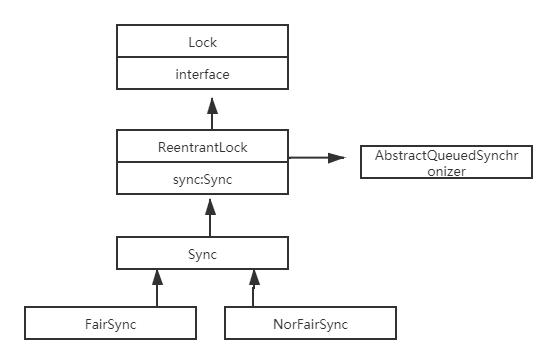AQS
- AbstractQueuedSynchronizer 抽象队列同步器,用来构建锁或者其它同步器组件的重量级基础框架及整个JUC体系的基石,通过内置的FIFO队列来完成资源获取线程的排队工作,并通过一个int类型变量state表示持有锁的状态。
AQS为什么是JUC的基石
- ReentranLock|CountDownLatch|Semaphore|ReentranReadWirteLock等都与AQS相关
- 锁与同步器的关系
- 锁 : 面向锁的使用者,定义了程序员与锁教会的使用层API
- 同步器:面向锁的实现者,简化了锁实现,屏蔽了同步状态管理、阻塞线程排队和通知、唤醒机制等
AQS源码体系
- AQS使用一个volatile的int类型成员变量来表示同步状态,通过内置的FIFO队列完成资源获取的排队工作,将每条要去抢占资源的线程封装成一个Node节点实现锁的分配,通过CAS完成对state值的修改。
由ReentrantLock解析AQS源码

- 加锁过程,分为三步
- 尝试加锁
- 加锁失败,线程进入队列
- 线程进入队列,进入阻塞状态
lock()方法
- 假设一个场景,三个线程A\B\C获取资源,此时A占用了锁
- 此时B线程进入lock方法
/**非公平锁实现,CAS判断AQS中state是不是0,即是否被占用
*如果CAS为true,调用AQS的setExclusiveOwnerThread,设置占用窗口的锁
*如果false,调用acquire()方法,由于是B线程进入,走acquire方法
**/
final void lock() {
if (compareAndSetState(0, 1))
setExclusiveOwnerThread(Thread.currentThread());
else
acquire(1);
}
acquire() 尝试获取锁
public final void acquire(int arg) {
if (!tryAcquire(arg) &&
acquireQueued(addWaiter(Node.EXCLUSIVE), arg))
selfInterrupt();
}
/** acquire 【尝试获取锁方法】中的tryAcquire实现,nonfairTryAcquire方法
*tryAcquire是AQS父类定义方法,有公平锁和非公平锁实现,看非公平代码
*先判断当前getState是否是0,即锁是否有占用,按假设此时A线程占用,判断不进入
*判断当前线程是否等于占用窗口的线程,也不进入,总体返回false
* 则取反 !tryAcquire(arg)是true
* - 如果此时A线程释放了锁,B线程进入nonfairTryAcquire,获取到了c == 0,则设置state =1 ,并设置了占用窗口的线程
- 还有一种情况,A线程重入,则nonfairTryAcquire走current == getExclusiveOwnerThread(),这种情况下state > 1
*/
final boolean nonfairTryAcquire(int acquires) {
final Thread current = Thread.currentThread();
int c = getState();
//A线程放锁
if (c == 0) {
if (compareAndSetState(0, acquires)) {
setExclusiveOwnerThread(current);
return true;
}
}
//A线程重入
else if (current == getExclusiveOwnerThread()) {
int nextc = c + acquires;
if (nextc < 0) // overflow
throw new Error("Maximum lock count exceeded");
setState(nextc);
return true;
}
return false;
}
/**addWaiter 【尝试获取锁未成功,就要使用该方法将其加入同步队列尾部】
*该方法入参Node.EXCLUSIVE,即下一个等候的线程,
*B线程进入由于还没有新建队列,tail为null
*B线程进入enq方法
*/
private Node addWaiter(Node mode) {
Node node = new Node(Thread.currentThread(), mode);
// 尾节点
Node pred = tail;
//后续C线程进入不进入此方法
if (pred != null) {
node.prev = pred;
if (compareAndSetTail(pred, node)) {
pred.next = node;
return node;
}
}
enq(node);
return node;
}
/**enq 入队方法
*t == null 初始化一个空Node伪节点,首尾相等
*第二个节点才保持进入的B线程,入队
*C 线程进入了,直接走else方法
*/
private Node enq(final Node node) {
for (;;) {
Node t = tail;
if (t == null) {
//初始化,new 一个空的Node节点
if (compareAndSetHead(new Node()))
tail = head;
} else {
node.prev = t;
if (compareAndSetTail(t, node)) {
t.next = node;
return t;
}
}
}
}
acquireQueued() 方法
/** acquireQueued【一旦加入同步队列,就需要使用该方法,自旋阻塞唤醒来不断的尝试获取锁,直到被中断或获取到锁】
*此时入参进入的是B节点
*假设B线程尝试获取锁失败 进入shouldParkAfterFailedAcquire 、parkAndCheckInterrupt方法
*shouldParkAfterFailedAcquire 如果前驱节点的waitStatus是SIGNAL状态,返回true,则会走 parkAndCheckInterrupt方法
*parkAndCheckInterrupt 调用 LockSupport.park(this); B线程被挂起,进入了候客区,等待uppark调用
*/
final boolean acquireQueued(final Node node, int arg) {
//取消排队标记
boolean failed = true;
try {
boolean interrupted = false;
//自旋
for (;;) {
//p是队列第一个节点,哨兵节点
final Node p = node.predecessor();
//p是哨兵节点,再尝试获取锁
if (p == head && tryAcquire(arg)) {
setHead(node);
p.next = null; // help GC
failed = false;
return interrupted;
}
if (shouldParkAfterFailedAcquire(p, node) &&
parkAndCheckInterrupt())
interrupted = true;
}
} finally {
if (failed)
cancelAcquire(node);
}
}
unlock()方法
+解锁调用realese方法
public final boolean release(int arg) {
if (tryRelease(arg)) {
//获取头节点
Node h = head;
if (h != null && h.waitStatus != 0)
//解锁唤醒其它线程LockSupport.unpark(s.thread);
unparkSuccessor(h);
return true;
}
return false;
}
/**
*此方法把state设置为0
* setExclusiveOwnerThread = null
* 返回true,表示解锁成功
*/
protected final boolean tryRelease(int releases) {
//入参releases = 1 ,如果没有重入的话,此时c =0
int c = getState() - releases;
//判断当前线程就是拿锁的哪个
if (Thread.currentThread() != getExclusiveOwnerThread())
throw new IllegalMonitorStateException();
boolean free = false;
if (c == 0) {
free = true;
setExclusiveOwnerThread(null);
}
setState(c);
return free;
}
